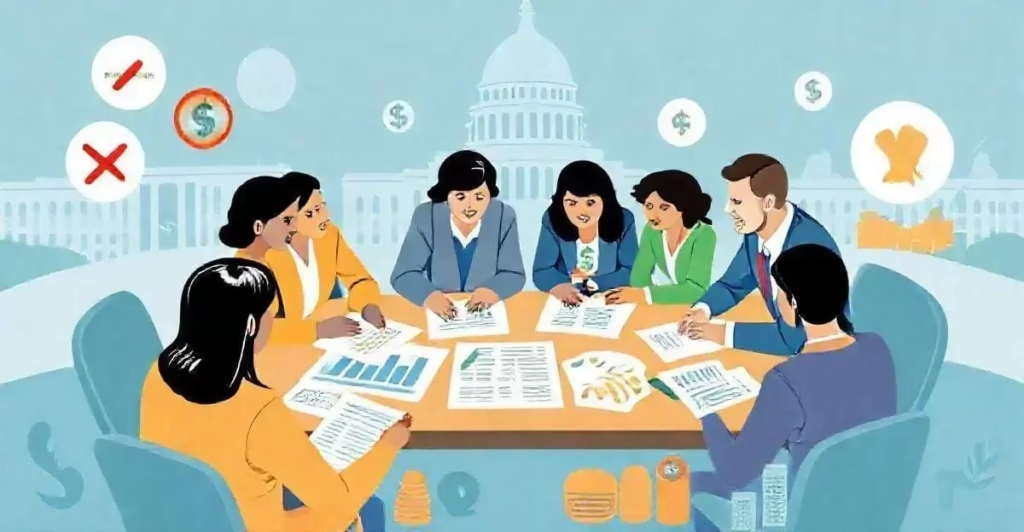As we try to get the economy back on track, we wonder: what’s the role of small businesses? How can they help the local economy grow? Small businesses are key to the American economy. They are vital for jobs and economic growth.
Eric Van Nostrand, Assistant Secretary for Economic Policy, says small businesses are huge. They employ half of Americans working for private companies1. This shows their big impact on jobs. They’ve also created over 70 percent of new jobs in the last few years1.
Key Takeaways
- Small businesses are the backbone of the American economy, driving economic recovery and local businesses and economic growth.
- Half of all Americans working for private businesses are employed by small businesses1.
- Small businesses have created over 70 percent of net new jobs in the last few years1, showing their big role in recovery.
- The role of small businesses in economic recovery is key, with big impacts on jobs and the local economy.
- Supporting small businesses is vital for economic recovery, innovation, and local growth.
- Small businesses make up about 51 percent of private jobs, with firms under 250 employees making up 44 percent of total private jobs1.
- American businesses have invested $430 billion more in business investment during the current cycle compared to usual2.
Understanding Economic Recovery After Crises
Economic recovery after crises is complex, involving government policies, consumer behavior, and business strategies3. Knowing the history of economic recovery helps create good plans for small businesses. Crises hit local economies hard, but small businesses show great resilience, showing their key role in recovery4.
Important factors for recovery include stock market trends, retail sales, and new business startups3. Central banks also play a part by adjusting money supply and encouraging loans3. Business loans are vital for growth, providing capital to businesses4. The U.S. has seen strong recovery from COVID-19, outperforming other G10 countries in investment and GDP per capita5.
Small businesses’ resilience in downturns is key. Supporting them helps build a stronger economy4. Their ability to adapt and innovate drives economic growth3.
By using these strategies, we can help small businesses grow and drive economic recovery3.
Small Businesses: The Backbone of the Economy
Independent businesses are key to the economy’s health. They make up 99.9% of all U.S. companies and employ nearly half of the private sector. This highlights their major role in job creation and economic growth.
These businesses are powerful job creators, generating two out of every three new positions in the private sector. They’re also optimistic, with over 70% expecting revenue growth soon. Plus, entrepreneurship is booming, with 16 million new business applications from 2021 to 2023—a record high.
Statistics on Small Business Contributions
Here are some key facts about small businesses’ impact:
- They’ve created over 70 percent of net new jobs in the last few years6
- The U.S. is seeing 430,000 new business applications monthly in 2024, up 50 percent from 20196
- Over the last decade, small businesses have been behind more than half of all net job growth7
Employment Rates and Small Businesses
Independent businesses are crucial for employment, as they employ nearly half of the private workforce, helping to maintain a strong labor market. Additionally, business ownership among Black families has doubled, reflecting greater diversity in entrepreneurship.

The Immediate Impact of COVID-19 on Small Enterprises
The COVID-19 pandemic hit independent businesses hard, with lockdowns and shifts in shopping habits affecting their operations and finances. In March 2021, unemployment in the Mountainland region was 2.5%, compared to the national 6.2%, showing how the crisis impacted local economies differently. This highlights the importance of strong recovery strategies for these businesses.
Locally owned enterprises play a crucial role in economic growth, and their recovery is essential for overall financial stability. The pandemic also created new opportunities for innovation and entrepreneurship. For example, China introduced special support measures like delayed tax payments and reduced R&D costs to help businesses stay afloat.
The economic impact of these businesses is complex. Understanding the challenges they face is essential for effective recovery plans. Key issues include lower consumer spending, disrupted supply chains, and limited access to funding. Addressing these obstacles can drive economic growth and speed up recovery efforts.
Supporting Small Businesses During a Crisis
As we navigate economic challenges, it’s important to recognize how independent businesses drive growth and resilience. They play a vital role, employing nearly 50% of America’s private sector workers and creating over 60% of new jobs in the last 25 years.
Government support and financial aid are crucial for these businesses to thrive. The SBA Economic Injury Disaster Loans (EIDL) provide low-interest funding to businesses affected by disasters or economic downturns. Local support groups and business networks also offer valuable assistance during tough times.
Initiatives like the Emergency Capital Investment Program (ECIP) have distributed $9 billion to support minority-owned and community-based enterprises. Programs such as Mastercard Strive have helped over 11.5 million businesses worldwide. Strengthening these businesses during a crisis ensures stability and fuels economic recovery.
Here are some key ways to support local businesses:
- Improve access to funding and loans
- Provide training and digital tools
- Foster community support and advocacy
By investing in these businesses, we empower them to drive economic growth and long-term success for everyone.ne10.

The Resilience of Small Businesses
Independent businesses prove they can adapt and grow even in challenging times. They are a cornerstone of the economy, accounting for 99.9% of all U.S. companies and employing nearly 47% of the private workforce, highlighting their major role in job creation.
With over 33 million independent businesses across the U.S., they provide employment for millions, reinforcing their economic impact. However, 27% are at risk of closing, making them vulnerable. Programs like R4R help them prepare for disasters and build long-term resilience.
These businesses are essential for economic recovery, creating about 1.5 million jobs annually and driving local growth. Without proper disaster planning, 50% may shut down within five years. That’s why having strategies to survive and recover is critical for their long-term success.

By understanding the value of small business resilience and using good recovery strategies, they can thrive. This helps local economies grow and develop1314.
Job Creation and Small Business Growth
Independent businesses play a major role in job creation. According to the U.S. Small Business Administration, they generate two out of every three new jobs in the private sector, highlighting their impact on employment growth. Under the Biden-Harris Administration, a record 17 million new business applications have been filed, leading to the creation of over 15 million jobs.
These businesses make up nearly half of the private workforce and are key drivers of innovation, continuously developing new products and services to meet evolving consumer demands. Small and medium-sized enterprises (SMEs) are especially crucial, contributing to about 80% of new jobs, particularly in developing countries. Here’s a table illustrating their significant role in job creation:
| Country | SMEs as a percentage of total employment |
|---|---|
| Developed countries | 50-66% |
| Developing countries | 80% |
Independent businesses also play a crucial role in economic growth. They drive innovation and create new opportunities, which in turn stimulates local economies, benefiting everyone. These businesses are essential for a strong economy, generating jobs and fueling growth.

Local Economies: The Ripple Effect
Independent businesses play a key role in boosting the economy and aiding recovery. They contribute to the local tax base, which helps fund schools, parks, and infrastructure improvements. These businesses are essential for job creation, reducing unemployment in our communities. They also support local causes by sponsoring events and donating to charities, helping to strengthen and unite our communities.
Supporting local businesses has many advantages:
- They help fund public services and improve our infrastructure17
- They create jobs, which cuts down on unemployment18
- They support local suppliers, encouraging creativity and taking risks17
When we support small businesses, we help the economy grow and recover. This support has a positive impact on our community. It benefits everyone, from local suppliers to our public services and infrastructure1817.
Access to Capital and Financing Challenges
Independent businesses are key to economic recovery, but they face significant challenges in securing capital. They play a vital role in the economy, making it essential to ensure they have access to the funding they need. Many business owners struggle to find the right financial information, making it harder to navigate funding options.
A better understanding of financial systems is crucial, which is why financial education is so important for business success.
These businesses drive job creation and innovation, yet many find it difficult to obtain the funds needed for growth. Around 70% say access to capital is a major factor in their expansion.
To support them, we must improve funding access through government initiatives like Small Business Administration (SBA) programs.
Key statistics highlight the financial challenges they face:
- Over 60% say loan applications are difficult due to excessive paperwork.
- About 43% have been denied loans because of poor credit history.
- Businesses with fewer than five employees make up 56% of all independent business jobs but struggle the most with funding access.
By addressing these barriers, we can help these businesses secure the capital they need. Strengthening their financial foundation is crucial for economic recovery, job creation, and continued innovation.
Technology Adoption Among Small Enterprises
Independent businesses are essential to economic recovery, especially through investing in digital transformation. The growth of e-commerce presents new opportunities for them to reach broader audiences and increase sales. Data shows that 45% of businesses with high digital adoption saw revenue growth, compared to 30% of those with low adoption.
The pandemic has accelerated technology adoption in these businesses, pushing them to embrace digital tools for expanding operations. This shift has helped them attract new customers and increase sales. Tools like Shopify’s Sidekick, which uses AI, have improved efficiency in product management and marketing.
Independent businesses play a significant role in the economy. With the right technology and support, they can drive growth and job creation. Continuing to support their adoption of technology is crucial for a brighter future.
| Category | High Digital Adoption | Low Digital Adoption |
|---|---|---|
| Revenue Growth | 45% | 30% |
| Productivity Gains | 67% | 36% |
The Future of Small Businesses in Economic Recovery
Looking ahead, independent businesses will play a key role in economic recovery. With nearly 33.19 million across the U.S., they serve as the backbone of the economy, generating over 17.3 million new jobs. Their recovery is essential for sustained growth.
Emerging trends in entrepreneurship, such as social impact ventures and increased diversity, will shape the future of these businesses. They contribute about 44% of the U.S. GDP, and in 2023, nearly 62 million Americans were employed by them. Supporting their recovery through access to capital and financial assistance is crucial during challenging times.
Here are some key ways to help independent businesses rebuild and grow:
- Expand access to capital and financing options.
- Provide training and resources to help them adapt to market changes.
- Prioritize stabilization efforts in disaster recovery plans.
By implementing these strategies, we can ensure these businesses continue to thrive, driving economic recovery and long-term success.
Building Stronger Partnerships
We recognize the importance of collaboration between independent and large businesses for the health of the economy. Supporting the growth of independent businesses strengthens our economy. When we spend money at local shops, it boosts the local economy far more than spending at big chains.
Local economies are more resilient during tough times because they rely on community spending, as was evident during the COVID-19 pandemic. The State Small Business Credit Initiative (SSBCI) highlights the critical role these businesses play in recovery, with nearly $10 billion allocated over 10 years to support them.
Trade associations are also key to building strong partnerships. They provide support, resources, and networking opportunities, helping independent businesses thrive.. Together, we can help small businesses grow, which helps the economy recover.
| Program | Funding | Number of Businesses Supported |
|---|---|---|
| SSBCI | $10 billion | 3,600 |
| Loan Participation Program (LPP) | $2.7 billion | Not specified |
Conclusion: A Collective Effort for Recovery
The recovery of independent businesses is a collective effort. Governments, communities, and individuals all have a role to play. Supporting these businesses is crucial for economic growth, as they create jobs, drive innovation, and strengthen local economies.
Eric Van Nostrand emphasizes that these businesses are essential to the economy, making their recovery vital for sustained growth. Communities can contribute by offering resources and support, helping businesses thrive and fuel economic recovery.
Why Supporting Small Businesses Matters
Small businesses are the heart of many economies. They create jobs and boost local development28. During tough times, they show resilience and adaptability. Their recovery is key for a strong economic rebound.
By supporting them, we create jobs, spark innovation, and strengthen community bonds.
How Communities Can Foster Growth
Local communities play a crucial role in the growth of independent businesses. Through partnerships and networks, they provide the support needed for success. By working together, we can help these businesses overcome challenges and drive economic recovery.
Independent businesses are major contributors to employment, shaping local economies. After major disasters, like the 2011 floods in Thailand, they often struggle to rebuild. However, those that adapt to climate change tend to be more resilient and better prepared for future challenges.
Studies show that strong small business networks lead to faster recovery after floods. SMEs that work with governments and private sectors recover faster too.
FAQ
What is the critical role of small businesses in economic recovery?
How have small businesses been impacted by the COVID-19 pandemic?
What government initiatives and support systems are available for small businesses during a crisis?
How have small businesses demonstrated resilience and adapted to the challenges posed by the pandemic?
What role do small businesses play in job creation and economic growth?
How do small businesses impact local economies?
What are the challenges small businesses face in accessing capital and financing?
How has the pandemic accelerated the adoption of technology among small businesses?
What are the emerging trends shaping the future of small businesses in economic recovery?
How can communities and partnerships support the recovery of small businesses?
Source: The Wall Street Journal | Related articles: Quora / Gettr




